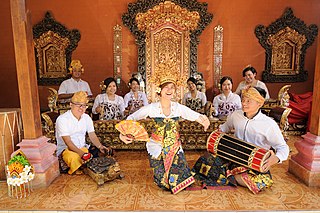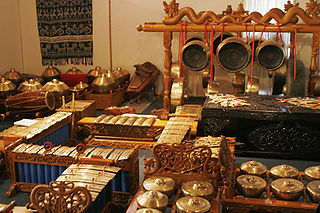
Gamelan is the traditional ensemble music of the Javanese, Sundanese, and Balinese peoples of Indonesia, made up predominantly of percussive instruments. The most common instruments used are metallophones played by mallets and a set of hand-played drums called kendhang/Kendang, which register the beat. The kemanak and gangsa are commonly used gamelan instruments in Bali. Other instruments include xylophones, bamboo flutes, a bowed instrument called a rebab, a zither-like instrument siter and vocalists named sindhen (female) or gerong (male).

As it is a country with many different tribes and ethnic groups, the music of Indonesia itself is also very diverse, coming in hundreds of different forms and styles. Every region have its own culture and art, and as a result traditional music from area to area also uniquely differs from one another. For example, each traditional music are often accompanied by their very own dance and theatre. Contemporary music scene have also been heavily shaped by various foreign influences, such as America, Britain, Japan, Korea, and India.

Balinese is a Malayo-Polynesian language spoken by 3.3 million people on the Indonesian island of Bali, as well as Northern Nusa Penida, Western Lombok, Eastern Java, Southern Sumatra, and Sulawesi. Most Balinese speakers also know Indonesian. The Bali Cultural Agency estimated in 2011 that the number of people still using the Balinese language in their daily lives on the Bali Island is under 1 million. The language has been classified as "not endangered" by Glottolog.

Gamelan gong kebyar is a style or genre of Balinese gamelan music of Indonesia. Kebyar means "to flare up or burst open", and refers to the explosive changes in tempo and dynamics characteristic of the style.

The Music of Bali, Bali is an Indonesian island that shares in the gamelan and other Indonesian musical styles. Bali, however, has its own techniques and styles, including kecak, a form of singing that imitates the sound of monkeys. In addition, the island is home to several unique kinds of gamelan, including the gamelan jegog, gamelan gong gede, gamelan gambang, gamelan selunding and gamelan semar pegulingan, the cremation music angklung and the processional music bebonangan. Modern popular styles include gamelan gong kebyar, dance music which developed during the Dutch occupation and 1950s era joged bumbung, another popular dance style. In Balinese music you can also hear metallophones, gongs and xylophones.

A guitar solo is a melodic passage, instrumental section, or entire piece of music, pre-written to be played on a classical, electric, or acoustic guitar. In 20th and 21st century traditional music and popular music such as blues, swing, jazz, jazz fusion, rock and heavy metal, guitar solos often contain virtuoso techniques and varying degrees of improvisation. Guitar solos on classical guitar, which are typically written in musical notation, are also used in classical music forms such as chamber music and concertos.

The angklung is a musical instrument from the Sundanese people in Indonesia made of a varying number of bamboo tubes attached to a bamboo frame. The tubes are carved to have a resonant pitch when struck and are tuned to octaves, similar to Western handbells. The base of the frame is held in one hand, while the other hand shakes the instrument, causing a repeating note to sound. Each performer in an angklung ensemble is typically responsible for just one pitch, sounding their individual angklung at the appropriate times to produce complete melodies.

Kotekan is a style of playing fast interlocking parts in most varieties of Balinese Gamelan music, including Gamelan gong kebyar, Gamelan angklung, Gamelan jegog and others.

A gangsa is a type of metallophone which is used mainly in Balinese and Javanese Gamelan music in Indonesia. In Balinese gong kebyar styles, there are two types of gangsa typically used: the smaller, higher pitched kantilan and the larger pemade. Each instrument consists of several tuned metal bars each placed over an individual resonator. The bars are hit with a wooden panggul, each producing a different pitch. Duration of sound intensity and sound quality factors are generally accomplished by damping the vibration of the bar with the fingers of the free hand. Balinese gong kebyar gangsas, as with other metallophones in gong kebyar ensembles, are played in neighboring pairs with interlocking, rapid-tempo parts that elaborate on the melody of a piece of music ; these pairs are tuned to be dissonant and create certain wavelengths of sympathetic vibrations to create a shimmering tone that travels long distances. The gangsa is very similar to the old gendér and the saron.

A gendèr is a type of metallophone used in Balinese and Javanese gamelan music. It consists of 10 to 14 tuned metal bars suspended over a tuned resonator of bamboo or metal, which are tapped with a mallet made of wooden disks (Bali) or a padded wooden disk (Java). Each key is a note of a different pitch, often extending a little more than two octaves. There are five notes per octave, so in the seven-note pélog scale, some pitches are left out according to the pathet. Most gamelans include three gendèr, one for sléndro, one for pelog pathet nem and lima, and one for pelog pathet barang.

Shred guitar or shredding is a virtuoso style of playing the electric guitar, based on various advanced and complex playing techniques, particularly rapid passages and advanced performance effects. Shred guitar includes fast alternate picking, sweep-picked arpeggios, diminished and harmonic scales, finger-tapping and whammy bar use. It is commonly used in heavy metal, where guitarists use the electric guitar with a guitar amplifier and a range of electronic effects such as distortion, which create a more sustained guitar tone and facilitate guitar feedback effects.

I Dewa Gede Budjana is an Indonesian guitarist, songwriter and composer. He is the lead guitarist and songwriter of the band Gigi. Budjana's style changed dramatically to jazz as he got to know John McLaughlin, Pat Metheny, Jeff Beck, John Abercrombie, Chick Corea, and Weather Report. In his early experience, he established a band called "Squirrell" which was popular in the local community. Throughout his musical experience in Indonesia, Dewa Budjana has collaborated with many famous guitarists such as Tohpati, Balawan, Ridho, Abdee Negara, and many more. Besides his collaboration with Indonesian musicians, he has also made collaborations with international musicians such as Vinnie Colaiuta, John Frusciante, Peter Erskine, Jimmy Johnson, Antonio Sanchez, Joe Locke, Gary Husband, Jack DeJohnette, Tony Levin, Jordan Rudess, Bob Mintzer and Guthrie Govan. His ability to combine not only jazz and rock but also traditional Balinese style have put him among the top Indonesian guitarists.
Tohpati Ario Hutomo is an Indonesian jazz guitarist and songwriter. He is known as one of the most famous jazz guitarists in Indonesia. He has collaborated with many Indonesian musicians such as Glenn Fredly, Indro, Arie Ayunir and Shakila. Many of his work has traditional culture elements as he always try to combine both modern and traditional Indonesian music on his albums. The influence came from many different international jazz guitarists, but the most significant influence came from Pat Metheny.

I Wayan Balawan, better known by the single name Balawan, is an Indonesian guitarist and songwriter. He is best known as a Batuan Ethnic Fusion guitarist and his ability to play double neck guitar. Balawan has developed the 8 Fingers Touch Style technique, which also known as the Touch-Tapping Style. He is often regarded as one of the fastest guitarists in Indonesia. He is also called The Magic Finger guitarist among the world's music community.

Gamelan gender wayang is a style of gamelan music played in Bali, Indonesia. It is required for wayang and most sacred Balinese Hindu rituals. The smallest of gamelan ensembles, it requires only two players and is complete at four, the additional instruments doubling an octave above. Like other gamelan genres, it incorporates delicate interlocking melodies and active contrapuntal movement, yet poses unique challenges in technique and composition.

Dance in Indonesia reflects the country's diversity of ethnicities and cultures. There are more than 1,300 ethnic groups in Indonesia. Austronesian roots and Melanesian tribal forms are visible, and influences ranging from neighboring Asian and even western styles through colonization. Each ethnic group has its own dances: there are more than 3,000 original dance forms in Indonesia. The old traditions of dance and drama are being preserved in the many dance schools which flourish not only in the courts but also in the modern, government-run or supervised art academies.

A gong chime is a generic term for a set of small, high-pitched bossed pot gongs. The gongs are ordinarily placed in order of pitch, with the boss upward on cords held in a low wooden frame. The frames can be rectangular or circular, and may have one or two rows of gongs. They are played by one to four musicians, each using two padded sticks to strike them. They are an important instrument in many Southeast Asian musical ensembles, such as Indonesian gamelan, kulintang, or Thai pi phat. For this reason, such ensembles are sometimes called "gong chime ensembles" or "gong chime orchestras," and the broad variety of music "gong chime music."
Christine Southworth is an American composer of postminimal music and works with combinations of Western ensembles, electronics, and world music ensembles including Balinese gamelan and bagpipes. She performs Balinese gamelan and gender wayang with Cambridge, Massachusetts-based Gamelan Galak Tika, as well as Galician Gaita and Great Highland Bagpipes. She co-founded Ensemble Robot, a cooperative of engineers, artists and musicians working together to invent robotic musical instruments. She was also the general manager of Gamelan Galak Tika from 2004 through 2013. Her own music incorporates her work with Balinese gamelan and with technology and electronics, as well as reaching beyond these influences with an expanded palette of contemporary classical, jazz and rock, and world music from Africa, Asia and Eastern Europe.

Barong dance is a style of traditional Balinese from Bali, Indonesia. The dance demonstrates about the mythological depiction of animals that have supernatural powers and could protect humans. Barong is the king of the spirits, leader of the hosts of good, and enemy of Rangda, the demon queen and mother of all spirit guarders in the mythological traditions of Bali. The Barong dance featured battle between Barong and Rangda to represent the eternal battle between good and evil.

















